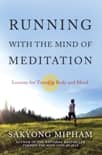
Even though there is a big difference between walking and running, many of the principles I have mentioned also apply to walking, probably the best of all exercises. It is low-impact, promotes circulation, and helps clear the mind. We should all enjoy a good walk, incorporating the qualities of mindfulness and gentleness.
Walking is traditionally used as a meditative discipline be- cause it is slow enough that one can easily focus. It is often used to break up periods of sitting. The walking meditation I describe here is also a walking yoga, with the right hand placed over the left fist just beneath the solar plexus. The technique consists of walking slowly and gently, taking short steps, and focusing on the placement of one foot heel to toe, the shift- ing of the weight, and then the placement of the other foot. There is a feeling of balance and harmony with the movement of the legs and feet as you bring mindfulness to your body. This walking meditation is a way to integrate the mind and body by slowing the mind down. It creates an excellent bridge between meditation and running.
In Tibet and other parts of the world, taking long walks as a pilgrimage from one sacred spot to another is considered a path to great spiritual merit. Propelled by the right motivation and attitude, these long walks can become a way to cleanse the body of negative karma and engender the mind with vir- tue. I have gone on walking pilgrimages to various holy sites, walking all day long. Such walks provide excellent exercise while also enriching the mind. I also enjoy going on treks and hikes.
My wife and I often go for walks together. In fact, I may run faster than she does, but she is a much better walker. It is a wonderful way to be with each other. We do not necessarily need to talk. Walking can be a way of clearing one’s mind as well as contemplating.
For me, practicing yoga has provided an excellent balance to running. Running can tend to tighten up the hips and the legs. Yoga loosens them. Yoga also provides a good transi- tion from being inactive to being very active, as in running. Moving fluidly and holding certain postures brings your awareness into your body, allowing for less discursiveness in the mind and more synchronicity—unity of mind and body. Depending on the kind of yoga you do and how you do it, moving fluidly and holding certain postures can bring a new level of awareness. By achieving a level of comfort with your body, you can develop more control and more intimacy with the breath. Controlling the breath al- lows you to access the mind. Having accessed the mind, you can access wisdom. Even very brief sessions of yoga are beneficial.
In a class, you may be intimidated by other practitioners who are incredibly flexible. However, that is their body, and this is your body.
In the beginning, it is not so much about pushing yourself to be flexible as about bringing your mind into the body, which creates a sense of embodiment. Even if you are not engaged in yoga in a deep way, you can still benefit from it by incorporating the mind into the body. Just moving the body into different positions, paying attention and breath- ing, automatically connects you with natural healthiness and confidence.

